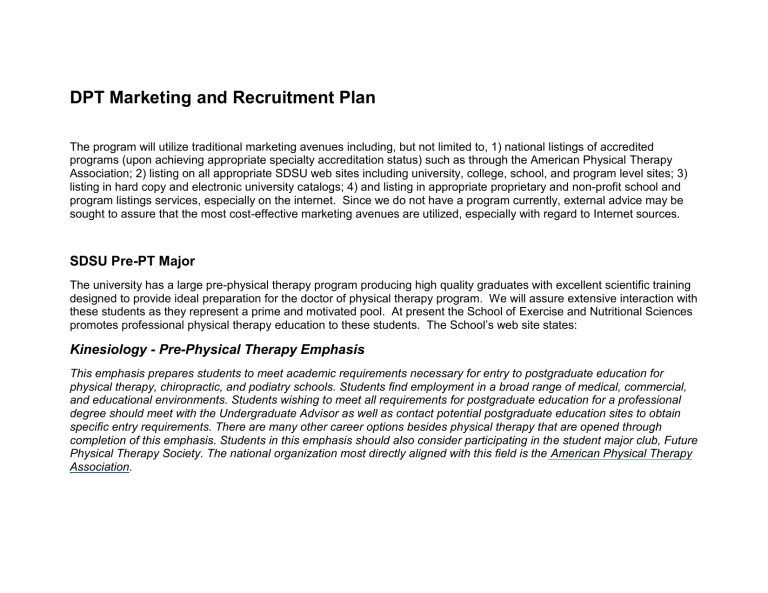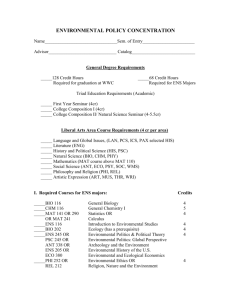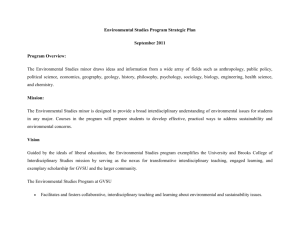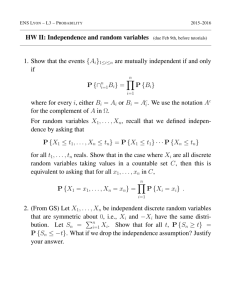DPT_Marketing_and_Recruitment_Plan

DPT Marketing and Recruitment Plan
The program will utilize traditional marketing avenues including, but not limited to, 1) national listings of accredited programs (upon achieving appropriate specialty accreditation status) such as through the American Physical Therapy
Association; 2) listing on all appropriate SDSU web sites including university, college, school, and program level sites; 3) listing in hard copy and electronic university catalogs; 4) and listing in appropriate proprietary and non-profit school and program listings services, especially on the internet. Since we do not have a program currently, external advice may be sought to assure that the most cost-effective marketing avenues are utilized, especially with regard to Internet sources.
SDSU Pre-PT Major
The university has a large pre-physical therapy program producing high quality graduates with excellent scientific training designed to provide ideal preparation for the doctor of physical therapy program. We will assure extensive interaction with these students as they represent a prime and motivated pool. At present the School of Exercise and Nutritional Sciences promotes professional physical therapy education to these students. The School’s web site states:
Kinesiology - Pre-Physical Therapy Emphasis
This emphasis prepares students to meet academic requirements necessary for entry to postgraduate education for physical therapy, chiropractic, and podiatry schools. Students find employment in a broad range of medical, commercial, and educational environments. Students wishing to meet all requirements for postgraduate education for a professional degree should meet with the Undergraduate Advisor as well as contact potential postgraduate education sites to obtain specific entry requirements. There are many other career options besides physical therapy that are opened through completion of this emphasis. Students in this emphasis should also consider participating in the student major club, Future
Physical Therapy Society. The national organization most directly aligned with this field is the American Physical Therapy
Association.
The number of pre-PT graduates by year is:
2006 2007 2008 2009 2010
73 97 98 134 159
In addition, students are provided with a specific, well designated, education plan to prepare for doctoral physical therapy program:
Model Program Schedule - Pre-Physical Therapy Emphasis
Semester 1
CHEM 200 (GE II A)
Composition (GE I)
ENS 210*
Unit
s
5
3
2
Pre Reqs
See General Catalog
See General Catalog
Humanities (GE II C) 3
Semester 2
BIOL 203 & 203L 4
CHEM 130 or
3
232
Int Comp (GE I) 3
Statistics
Units Pre Reqs
Course (GE II
A)#
3
GE Humanities 3
TOTAL 16
CHEM 200
CHEM 100 or 200
See General Catalog
See pg. 1 of advising sheet
Oral communication (GE I) 3
TOTAL 16
Semester 3
Unit
s
Pre Reqs Semester 4 Units Pre Reqs
BIOL 212 (GE II A)*
Humanities (GE II C)
ENS 104 A or B
PHYS 180 A#
PHYS 182 A
SOC 101 (GE II B)
3
1
3
4
3
1
BIOL 100 or 203
See advising sheet
Psych 101 (GE II
B)
3
BIOL 211 & 211L 4
Humanities (GE II
C)
ELM, Math Placement
PHYS 180 B#
Exam, Part 1A
PHYS 180A or concurrent PHYS 182 B
3
3
1
ENS 265/265L 2
NUTRI 201 3
BIOL 100 & CHEM 100 or
200
TOTAL 18
Writing Proficiency Assessment Required**
Semester 5
Unit
s
Pre Reqs
BIOL 336 (GE IV A)**
BIOL 436
ENS 301
ENS 303#
3
2
3
3
GE IIA
BIOL 336 or concurrent
ENS 210
#ENS 210, BIOL 212
ENS 305
TOTAL
3
14
ENS 210, statistics
Writing Proficiency Assessment Deadline **
TOTAL
Semester 6
GE IVB (rec SOC
355)
ENS 304#
ENS 306
ENS 307
ENS 304L
TOTAL
16
BIOL 203 & 203L
PHYS 180A
PHYS 180B
Credit or concurrent
BIOL 212
Unit
s
3
Pre Reqs
3
3
3
BIOL 336, #ENS 210
ENS 303
ENS 210, PSYCH 101, statistics
1 ENS 304 or concurrent
13
Semester 7
ENS 302
Unit
s
3
Pre Reqs
ENS 210
Semester 8
GE American
Institutions
ENS 388
Units Pre Reqs
3
ENS 363 3 ENS 303,304 1
ENS 436 3
GE American Institutions 3
Humanities (GE IV C)
TOTAL
3
15
ENS 304, 304L, 305, 306,
307
GRAND TOTAL = 120 UNITS
Required Impactions GPA 2.8
Chem 130 is a spring only class
*Need grade of C or better
#Must satisfy ELM, pass Math Dept Placement Exam Part 1A prior.
** Must be taken in the semester in which you earn 60 units.
ENS 401A/401B 2
PSYCH 350
Electives
TOTAL
3
3
12
ENS 363 or senior standing
ENS 304, 304L, 306
PSYCH 101
The key point of this part of our marketing plan is that we have in our own environment a highly regarded program preparing students specifically for the doctor of physical therapy. This provides excellent and well-prepared candidates to fill at least a significant percentage of the available slots.
In addition, students in other majors at SDSU will likely have an interest in the program. The university has an aggressive health professions program for students in all majors seeking postbachelor’s level education in the health sciences, potentially including physical therapy. Finally, students at other local universities are also a pool of potential applicants, especially those at UCSD, USD, and Cal State San Marcos.
Local PT Resources
An additional focus of the marketing plan will be to access local physical therapy professionals and organizations, and health care provider originations, to assure that they are acutely aware of the program. This includes the San Diego
Chapter of the California Physical Therapy Association. Outreach to local PT related professional meetings will be conducted as well.
Most importantly, we have extensive ties to local health care providers, especially hospitals and large multi-specialty clinical and health maintenance organizations. We will use those connections to distribute information about the program.
This effort will be concurrent with our needs to seek local training sites. We already do much of this in connection with our nursing programs and, to a lesser extent, audiology and speech pathology.
Social Media
We will seek to use social media for advertising purposes. We will identify university and relevant professional social media outlets likely to reach potential students and others who can spread the word further. SDSU has a success record in student recruitment for other graduate programs and at the undergraduate level.
Other Media
SDSU has a marketing and communications department. Their role is summarized on their web pages:
The Department of Marketing & Communications, in the Division of University Relations and
Development, is the voice of SDSU.
SDSU Marketing & Communications embraces emerging communications technologies to share the university's best stories with the public.
Department initiatives reach ever-expanding audiences, from the university's 200,000 living alumni to the region's 3 million-plus population who rely on SDSU graduates to power the local economy. Through news media, government relations, campus programs and community outreach, SDSU Marketing &
Communications develops initiatives that support the university's mission, projects and programs — namely excellent teaching, research and community service.
This department can reach the local and regional communities, public media including print and other mass media, and utilize their own publications to advertise new programs. They maintain a university blog, an alumni magazine, and an
Internet presence.
Brochure
The CHHS has in house graphics capability whose talents will be used to develop attractive brochures. A draft of the program preliminary announcement brochure is attached. More extensive marketing materials will be developed during the start-up year.
Where Do Physical Therapists Practice?
Although many physical therapists practice in hospitals, more than 80 percent practice in:
Outpatient clinics or offices
Inpatient rehabilitation facilities
Skilled nursing, extended care, or subacute facilities
Homes
Education or research centers
Schools
Hospices
Industrial, workplace, or other occupational environments
Fitness centers and sports training facilities
Physical Therapist (PT) Careers Overview
Patients/clients and physicians are demanding the talents of physical therapists for management of a wide variety of conditions. In many cases, patients are being sent to physical therapy instead of surgery, and they highly value the individualized, "hands on" approach that characterizes physical therapist care. When a physical therapist sees a patient/client for the first time, he or she examines that individual and develops a plan of care that promotes the ability to
move, reduces pain, restores function, and prevents disability. The physical therapist and the patient/client then work sideby-side to make sure that the goals of the plan or care are met.
Therapeutic exercise and functional training are the cornerstones of physical therapist treatment. Depending on the particular needs of a patient/client, physical therapists may "manipulate" a joint (that is, perform certain types of passive movements at the end of the individual's range of motion) or massage a muscle to promote proper movement and function. Physical therapists may use other techniques such as electrotherapy, ultrasound (high-frequency waves that produce heat), hot packs, and ice in addition to other treatments when appropriate. Physical therapists also will work with individuals to prevent loss of mobility by developing fitness- and wellness-oriented programs for healthier and more active lifestyles.
Practice Settings
Although many physical therapists practice in hospitals, more than 80% practice in other settings.
Acute Care - In this setting, physical therapy is provided to individuals who are admitted to a hospital for short-term patient care for reasons such as illness, surgery, accident, or recovery from a trauma. The goal in this setting is to discharge the person as soon as he or she is medically stable and has a safe place to go.
Rehab/Sub Acute Rehab
Rehabilitation Hospital - In this setting, physical therapy is provided to individuals who are admitted to a facility or rehabilitation unit. The goal is this setting is to provide intense therapy to improve the person's ability to care for himself or herself (typically 3 hours or more per day).
Sub-Acute Rehabilitation - In this setting, physical therapy is provided to individuals who are admitted to a special hospital that provides medical and/or rehabilitation care. The rehabilitation is less intense
(typically less than 3 hours per day).
Extended Care Facility /Nursing Home/Skilled Nursing Facility - In this setting, physical therapy is provided to individuals who are admitted to a facility that typically cares for elderly patients and provides long-term nursing care, rehabilitation, and other services.
Outpatient Clinic (also known as a Private Practice ) - In this common physical therapy setting, individuals visit a physical therapist in a clinic, office, or other health care facility primarily to address musculoskeletal (orthopedic) and neuromuscular injuries or impairments.
School/Pre-school - In this setting, physical therapy is provided within an educational environment, including pre-school, elementary, or secondary education (high school and vocational) facilities.
Wellness/Prevention/Sports/Fitness - In this setting, physical therapy is provided to individuals with a focus on wellness. This approach to health care emphasizes preventing illness and injury and promoting a healthy lifestyle, as opposed to emphasizing treatment of diseases. Settings may include but aren't limited to fitness centers and sports training facilities.
Home Health - In this setting, physical therapy is provided in the patient's place of residence. While the majority of patients are senior citizens, there also are pediatric patients with developmental disabilities and other conditions, and individuals of all ages who need rehabilitation because of injury or other causes. Home care may actually be provided in the patient's residence, the caregiver's home, a hospital emergency room, skilled nursing facility, residential facility, group home, hospice, or elsewhere in the community.
Hospice - In this setting, physical therapy is provided to patients in the last phases of incurable disease so that they may maintain functional abilities for as long as possible and manage pain.
Industrial, Workplace, or Other Occupational Environments - In these settings, physical therapy is provided to individuals primarily to help them return to work or for the purpose of enhancing employee health, improving safety, and increasing productivity in the workplace.
Local, State, and Federal Government - In these settings, physical therapy is provided to civilians and military personnel. PTs are employed by federal agencies, including the Veteran's Health Administration (VHA), Department of
Defense, and Indian Health Service (IHS).
Research Center - In this setting, physical therapists and other professionals conduct research to improve patient/client care outcomes and support the body of knowledge in the field physical therapy.
Some of the Conditions Treated by Physical Therapists
Arthritis
Balance
Back Pain
Burns
Carpal Tunnel Syndrome
Developmental
(COPD)
Chronic Obstructive Pulmonary Disease
Fractures
Headaches
Lymphedema
Pelvic Pain
Delays
Dislocations
Hand Injuries
Incontinence
Osteoporosis
Sports Injuries
Stroke
Injury (TBI)
Traumatic Brain
Job Satisfaction
Physical therapists report one of the highest job-satisfaction levels in the country! So says a recent National Opinion
Research Center survey, which was chronicled in an April 17, 2007, article of the Chicago Tribune . With more than threequarters of physical therapists polled reporting to be "very satisfied" with their occupations, PTs were second only to clergy, and were the only health care professionals in the top 5.
Job Outlook
Citing 2 national job satisfaction surveys, U.S. News & World Report added physical therapists to its list of best careers for
2009. Physical therapists also ranked 4th in a list of the 100 "Best Jobs in America" featured in the November 2010 issue of CNNMoney.com.
There is a high demand for physical therapists in the workforce despite the economic downturn. According to the Bureau of Labor Statistics, employment of physical therapists is expected to grow by 30 percent from 2008 to 2018, much faster than the average for all occupations. According to APTA, with just a 0.2 percent unemployment rate, physical therapists are now experiencing the best employment conditions since enactment of the Balanced Budget Act of 1997. The need for
PTs is expected to increase into the foreseeable future as the U.S. population ages and the demand for physical therapy services grows.






